Holistic Impact and Environmental Efficiency of Retrofitting Interventions on Buildings in the Mediterranean Area: A Directional Distance Function Approach
Abstract
:1. Introduction
2. Materials and Methods
2.1. Method: The Directional Distance Function and the Bootstrap Resampling Technique
2.2. Data
3. Results and Discussion
3.1. Holistic and Environmental Efficiency Scores for Typology of Buildings in All the Climate Zones
3.2. How to Choose the Optimal Solution within Each POS?
4. Conclusions
Author Contributions
Funding
Institutional Review Board Statement
Informed Consent Statement
Data Availability Statement
Conflicts of Interest
Appendix A
| Climate Zones | Winter | Summer |
|---|---|---|
| W1S1 | 0 ≤ CSI < 0.522 | 0 ≤ CSI < 0.508 |
| W2S2 | 0.522 ≤ CSI < 1.52 | 0.508 ≤ CSI < 1.34 |
| W2S3 | 0.522 ≤ CSI < 1.52 | 1.34 ≤ CSI < 2.00 |
| W3S2 | 1.52 ≤ CSI < 2.77 | 0.508 ≤ CSI < 1.34 |
References
- European Commission. (15 April 2019), New Rules for Greener And Smarter Buildings Will Increase Quality of Life for All Europeans. Available online: https://ec.europa.eu/info/news/new-rules-greener-and-smarter-buildings-will-increase-quality-life-all-europeans-2019-apr-15_en (accessed on 3 November 2021).
- Salmeron Lissen, J.M. (2020) D3.4—Calculations on Reference Buildings and Identification of Optimal Integrated Packages of Solutions. Available online: https://ec.europa.eu/research/participants/documents/downloadPublic?documentIds=080166e5ccfa6591&appId=PPGMS (accessed on 6 November 2021).
- EUR-Lex. Access to European Union Law. Available online: https://eur-lex.europa.eu/LexUriServ/LexUriServ.do?uri=OJ:L:2012:081:0018:0036:EN:PDF (accessed on 3 November 2021).
- Chung, Y.; Färe, R.; Grosskopf, S. Productivity and Undesirable Outputs: A Directional Distance Function Approach. J. Environ. Manag. 1997, 51, 229–240. [Google Scholar] [CrossRef] [Green Version]
- Faere, R.; Grosskopf, S.; Lovell, C.A.K.; Pasurka, C. Multilateral Productivity Comparisons When Some Outputs are Undesirable: A Nonparametric Approach. Rev. Econ. Stat. 1989, 71, 90. [Google Scholar] [CrossRef]
- Zofío, J.L.; Prieto, A.M. Environmental efficiency and regulatory standards: The case of CO2 emissions from OECD industries. Resour. Energy Econ. 2001, 23, 63–83. [Google Scholar] [CrossRef]
- Ball, V.E.; Lovell, C.A.K.; Luu, H.; Nehring, R. Incorporating environmental impacts in the measurement of agricultural productivity growth. J. Agric. Resour. Econ. 2004, 29, 436–460. [Google Scholar]
- Cuesta, R.A.; Zofío, J.L. Hyperbolic Efficiency and Parametric Distance Functions: With Application to Spanish Savings Banks. J. Prod. Anal. 2005, 24, 31–48. [Google Scholar] [CrossRef]
- Chambers, R.G.; Chung, Y.; Färe, R. Benefit and Distance Functions. J. Econ. Theory 1996, 70, 407–419. [Google Scholar] [CrossRef]
- Chambers, R.G.; Chung, Y.; Färe, R. Profit, Directional Distance Functions, and Nerlovian Efficiency. J. Optim. Theory Appl. 1998, 98, 351–364. [Google Scholar] [CrossRef]
- Färe, R.; Grosskopf, S.; Pasurka, C.A. Environmental production functions and environmental directional distance functions. Energy 2007, 32, 1055–1066. [Google Scholar] [CrossRef]
- McMullen, B.S.; Noh, D.-W. Accounting for emissions in the measurement of transit agency efficiency: A directional distance function approach. Transp. Res. Part D Transp. Environ. 2007, 12, 1–9. [Google Scholar] [CrossRef]
- Kumar, S.; Managi, S. Sulfur dioxide allowances: Trading and technological progress. Ecol. Econ. 2010, 69, 623–631. [Google Scholar] [CrossRef]
- Kumar, S.; Managi, S. Environment and productivities in developed and developing countries: The case of carbon dioxide and sulfur dioxide. J. Environ. Manag. 2010, 91, 1580–1592. [Google Scholar] [CrossRef]
- Zhang, C.; Liu, H.; Bressers, H.T.; Buchanan, K.S. Productivity growth and environmental regulations—Accounting for undesirable outputs: Analysis of China’s thirty provincial regions using the Malmquist–Luenberger index. Ecol. Econ. 2011, 70, 2369–2379. [Google Scholar] [CrossRef]
- Falavigna, G.; Manello, A.; Pavone, S. Environmental efficiency, productivity and public funds: The case of the Italian agricultural industry. Agric. Syst. 2013, 121, 73–80. [Google Scholar] [CrossRef]
- Falavigna, G.; Ippoliti, R. The socio-economic planning of a community nurses programme in mountain areas: A Directional Distance Function approach. Socio-Econ. Plan. Sci. 2019, 71, 100770. [Google Scholar] [CrossRef]
- Falavigna, G.; Ippoliti, R.; Manello, A.; Ramello, G.B. Judicial productivity, delay and efficiency: A Directional Distance Function (DDF) approach. Eur. J. Oper. Res. 2015, 240, 592–601. [Google Scholar] [CrossRef]
- Ibáñez-Forés, V.; Bovea, M.D.; Pérez-Belis, V. A holistic review of applied methodologies for assessing and selecting the optimal technological alternative from a sustainability perspective. J. Clean. Prod. 2014, 70, 259–281. [Google Scholar] [CrossRef]
- Álvarez-Rodríguez, C.; Martín-Gamboa, M.; Iribarren, D. Combined use of Data Envelopment Analysis and Life Cycle Assessment for operational and environmental benchmarking in the service sector: A case study of grocery stores. Sci. Total. Environ. 2019, 667, 799–808. [Google Scholar] [CrossRef] [PubMed]
- Pishgar-Komleh, S.H.; Żyłowski, T.; Rozakis, S.; Kozyra, J. Efficiency under different methods for incorporating undesirable outputs in an LCA+DEA framework: A case study of winter wheat production in Poland. J. Environ. Manag. 2020, 260, 110138. [Google Scholar] [CrossRef] [PubMed]
- Zhu, L.; Liu, J.; Xie, J.; Yu, Y.; Gao, L.; Li, S.; Duan, H. Can efficiency evaluation be applied to power plant operation improvement? A combined method with modified weighted russell directional distance model and pattern matching. Comput. Oper. Res. 2021, 134, 105406. [Google Scholar] [CrossRef]
- Liu, X.; Chu, J.; Yin, P.; Sun, J. DEA cross-efficiency evaluation considering undesirable output and ranking priority: A case study of eco-efficiency analysis of coal-fired power plants. J. Clean. Prod. 2017, 142, 877–885. [Google Scholar] [CrossRef]
- Joint Research Centre-European Commission. Handbook on Constructing Composite Indicators: Methodology and User Guide; Organisation for Economic Co-operation and Development: Paris, France, 2008; ISBN 978-92-64-04345-9. [Google Scholar]
- Dobos, I.; Vörösmarty, G. Green supplier selection and evaluation using DEA-type composite indicators. Int. J. Prod. Econ. 2014, 157, 273–278. [Google Scholar] [CrossRef]
- Andreolli, F.; Bragolusi, P.; D’Alpaos, C.; Faleschini, F.; Zanini, M.A. An AHP model for multiple-criteria prioritization of seismic retrofit solutions in gravity-designed industrial buildings. J. Build. Eng. 2021, 45, 103493. [Google Scholar] [CrossRef]
- Yang, L.; Ma, C.; Yang, Y.; Zhang, E.; Lv, H. Estimating the regional eco-efficiency in China based on bootstrapping by-production technologies. J. Clean. Prod. 2019, 243, 118550. [Google Scholar] [CrossRef]
- Falavigna, G.; Ippoliti, R. Reform policy to increase the judicial efficiency in Italy: The opportunity offered by EU post-Covid funds. J. Policy Model. 2021, 43, 923–943. [Google Scholar] [CrossRef]
- Färe, R.; Grosskopf, S. Theory and Application of Directional Distance Functions. J. Prod. Anal. 2000, 13, 93–103. [Google Scholar] [CrossRef]
- Cooper, W.W.; Seiford, L.M.; Tone, K. Data Envelopment Analysis: A Comprehensive Text with Models, Applications, References and DEA-Solver Software; Princeton University Press: Princeton, NJ, USA, 2007. [Google Scholar]
- Simar, L.; Wilson, P.W. Sensitivity Analysis of Efficiency Scores: How to Bootstrap in Nonparametric Frontier Models. Manag. Sci. 1998, 44, 49–61. [Google Scholar] [CrossRef] [Green Version]
- Simar, L.; Wilson, P.W. Estimation and inference in two-stage, semi-parametric models of production processes. J. Econ. 2007, 136, 31–64. [Google Scholar] [CrossRef]
- Chernick, M.R. Bootstrap Methods: A Guide for Practitioners and Researchers; John Wiley & Sons: Hoboken, NJ, USA, 2011; Volume 619. [Google Scholar]
- Falavigna, G.; Manello, A. The influence of financial and technological structure on eco-efficiency: An application of DDF bootstrapped framework in the Italian polluting industries. Int. J. Comput. Econ. Econom. 2021. Accepted paper, forthcoming. [Google Scholar]
- Riquelme, J.N.F.; Meré, J.B.O.; Zinilli, A.; Reale, E. The Proposal of a New Hybrid Methodology for the Impact Assessment of Energy Efficiency Interventions. An Exploratory Study; CNR-IRCrES Working Paper; Istituto di Ricerca sulla Crescita Economica Sostenibile: Roma, Italy, 2020. [Google Scholar] [CrossRef]
- Lissen, J.S.; Escudero, C.J.; De La Flor, F.S.; Escudero, M.; Karlessi, T.; Assimakopoulos, M.-N. Optimal Renovation Strategies through Life-Cycle Analysis in a Pilot Building Located in a Mild Mediterranean Climate. Appl. Sci. 2021, 11, 1423. [Google Scholar] [CrossRef]
- de Vasconcelos, A.B.; Pinheiro, M.D.; Manso, A.; Cabaço, A. EPBD cost-optimal methodology: Application to the thermal rehabilitation of the building envelope of a Portuguese residential reference building. Energy Build. 2016, 111, 12–25. [Google Scholar] [CrossRef]
- Wilson, P.W. Dimension reduction in nonparametric models of production. Eur. J. Oper. Res. 2018, 267, 349–367. [Google Scholar] [CrossRef]
- Filippi, M. Remarks on the green retrofitting of historic buildings in Italy. Energy Build. 2015, 95, 15–22. [Google Scholar] [CrossRef]
- Onecha, B.; Dotor, A.; Marmolejo-Duarte, C. Beyond Cultural and Historic Values, Sustainability as a New Kind of Value for Historic Buildings. Sustainability 2021, 13, 8248. [Google Scholar] [CrossRef]
- Webb, A.L. Energy retrofits in historic and traditional buildings: A review of problems and methods. Renew. Sustain. Energy Rev. 2017, 77, 748–759. [Google Scholar] [CrossRef]
- Mazzarella, L. Energy retrofit of historic and existing buildings. The legislative and regulatory point of view. Energy Build. 2015, 95, 23–31. [Google Scholar] [CrossRef]
- Iribarren, D.; Vázquez-Rowe, I.; Moreira, M.T.; Feijoo, G. Further potentials in the joint implementation of life cycle assessment and data envelopment analysis. Sci. Total. Environ. 2010, 408, 5265–5272. [Google Scholar] [CrossRef] [PubMed]
- Lozano, S.; Iribarren, D.; Moreira, M.T.; Feijoo, G. The link between operational efficiency and environmental impacts: A joint application of Life Cycle Assessment and Data Envelopment Analysis. Sci. Total. Environ. 2009, 407, 1744–1754. [Google Scholar] [CrossRef]
- Gamboa, M.M.; Iribarren, D.; García-Gusano, D.; Dufour, J. A review of life-cycle approaches coupled with data envelopment analysis within multi-criteria decision analysis for sustainability assessment of energy systems. J. Clean. Prod. 2017, 150, 164–174. [Google Scholar] [CrossRef]
- Ongpeng, J.M.C.; Rabe, B.I.B.; Razon, L.F.; Aviso, K.B.; Tan, R.R. A multi-criterion decision analysis framework for sustainable energy retrofit in buildings. Energy 2021, 239, 122315. [Google Scholar] [CrossRef]
- Akander, J.; Alvarez, S.; Johannesson, G. Chapter 3. Energy normalization techniques. In Energy Performance of Residential Buildings. A Practical Guide for Energy Rating and Efficiency; Santamouris, M., Ed.; James & James/Earthscan: London, UK, 2005; pp. 64–67. [Google Scholar]
- Salmeron, J.M.; Alvarez, S.; Molina, J.L.; Ruiz, A.; Sanchez, F.J. Tightening the energy consumptions of buildings depending on their typology and on Climate Severity Indexes. Energy Build. 2013, 58, 372–377. [Google Scholar] [CrossRef]
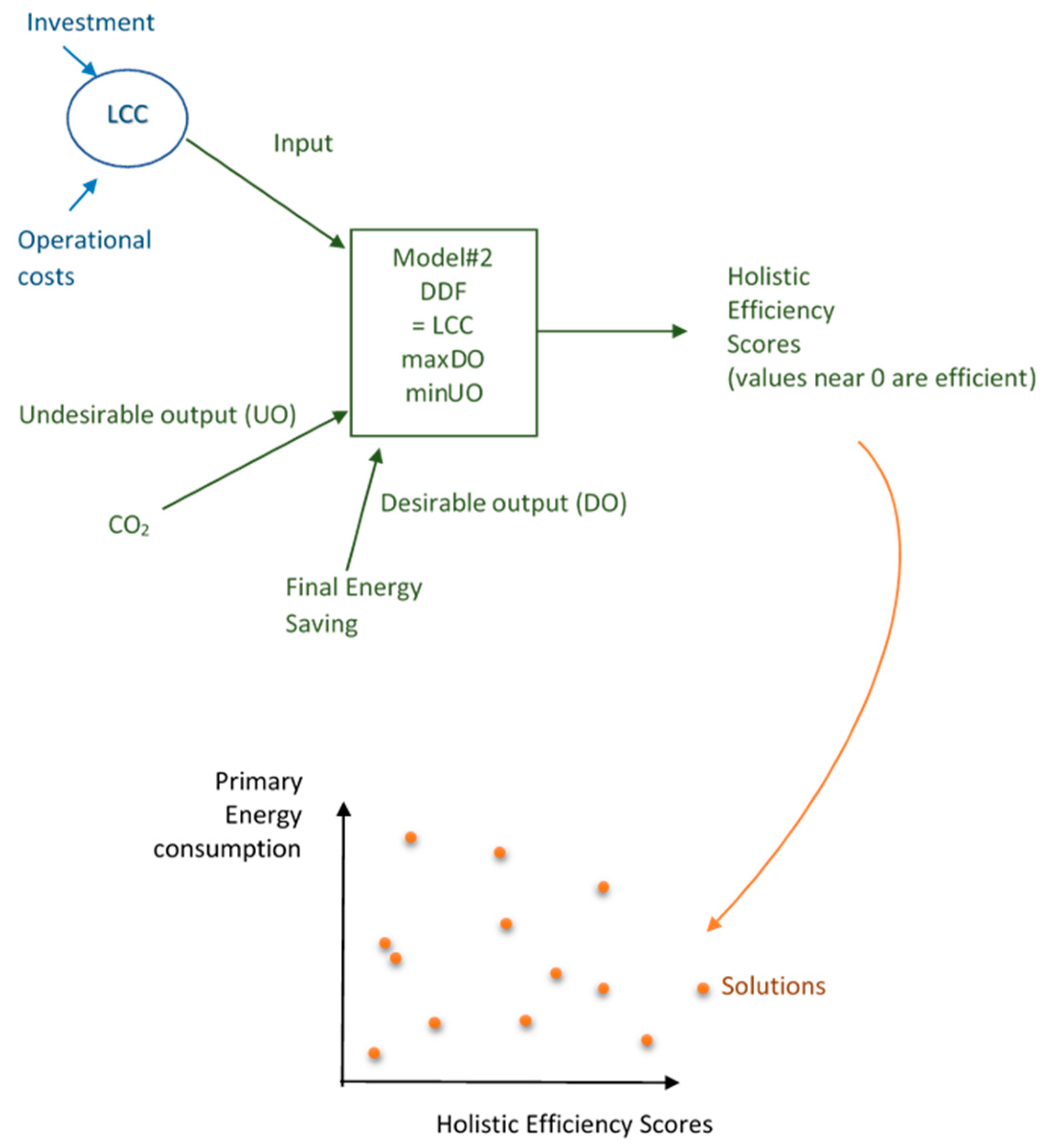
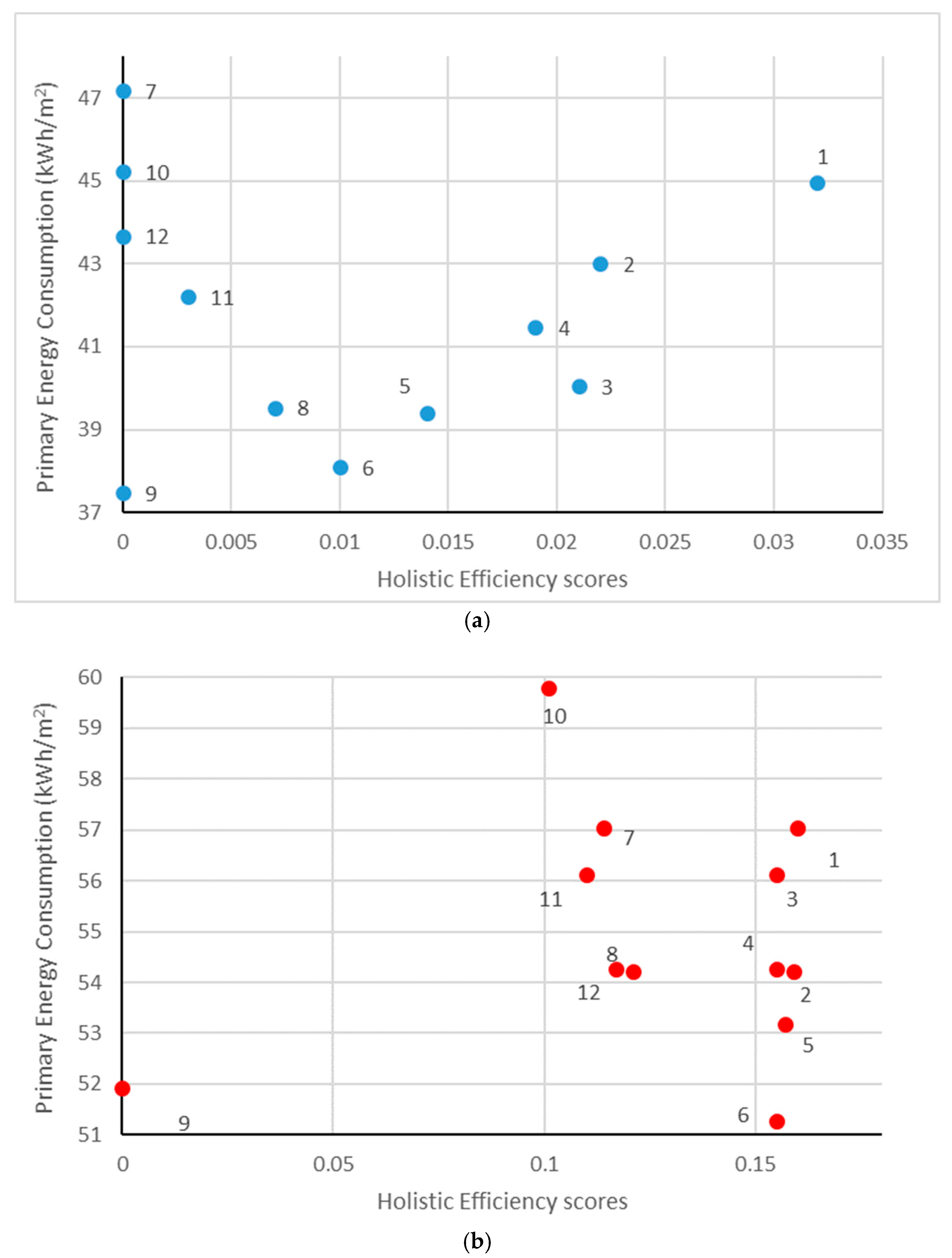
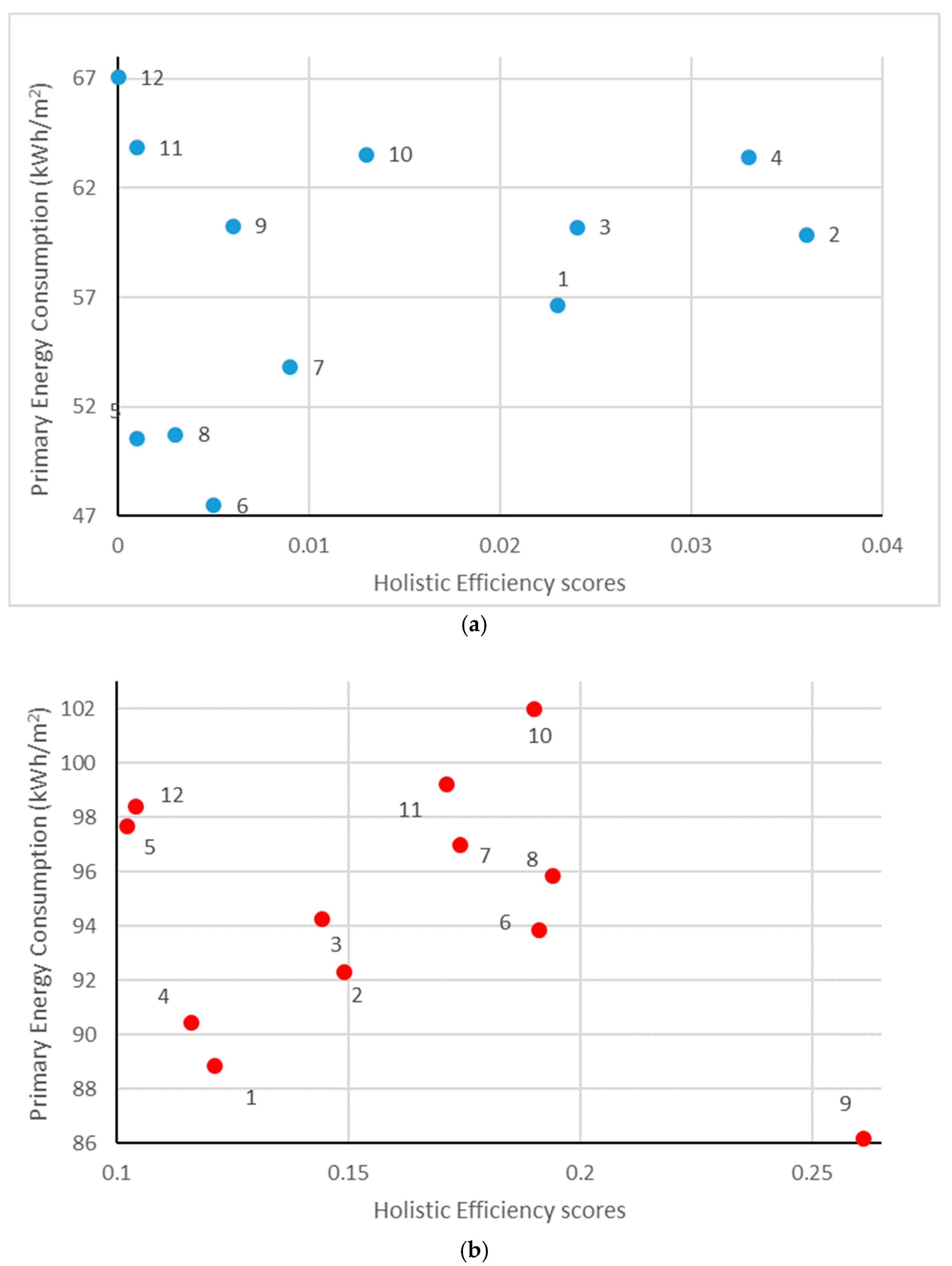
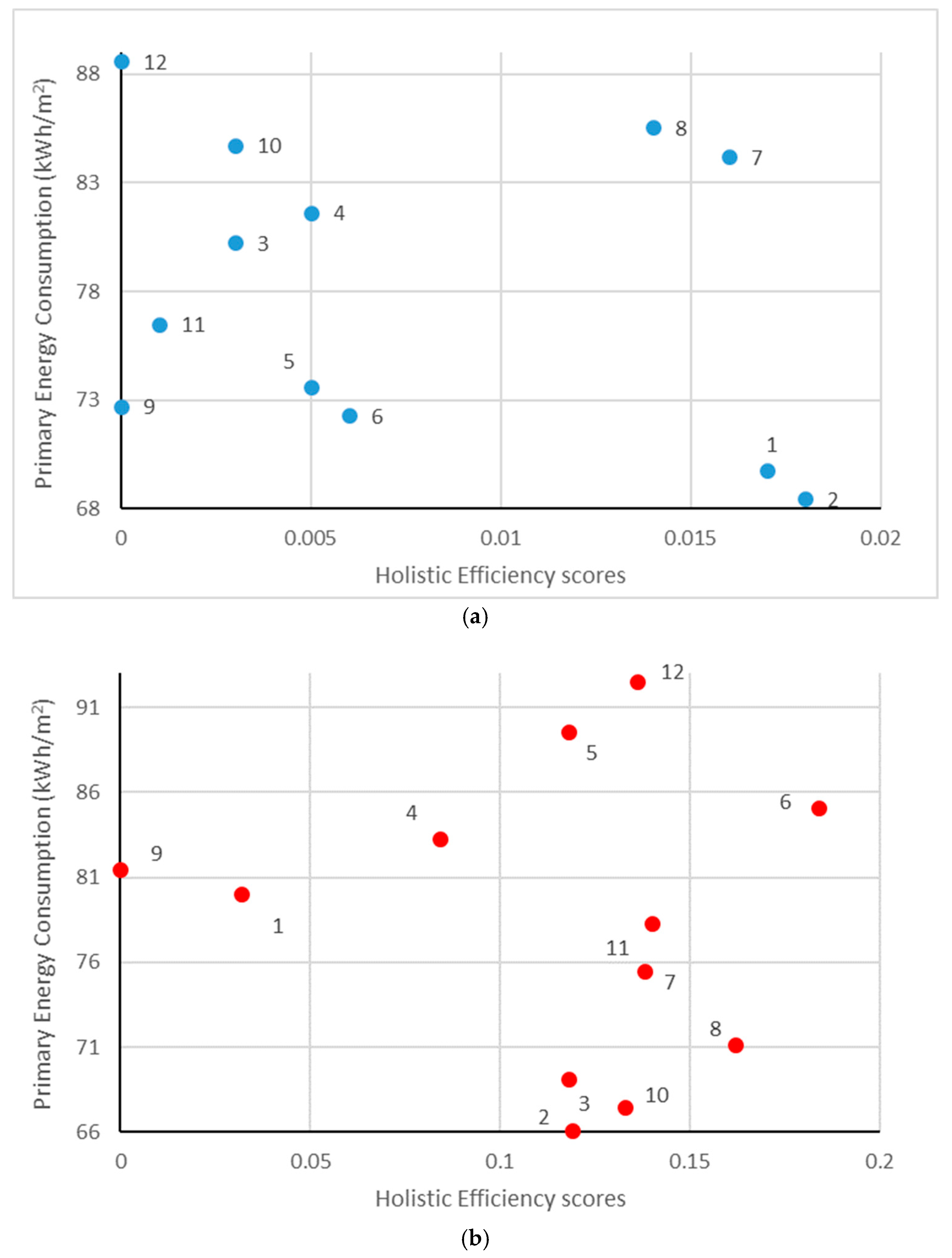
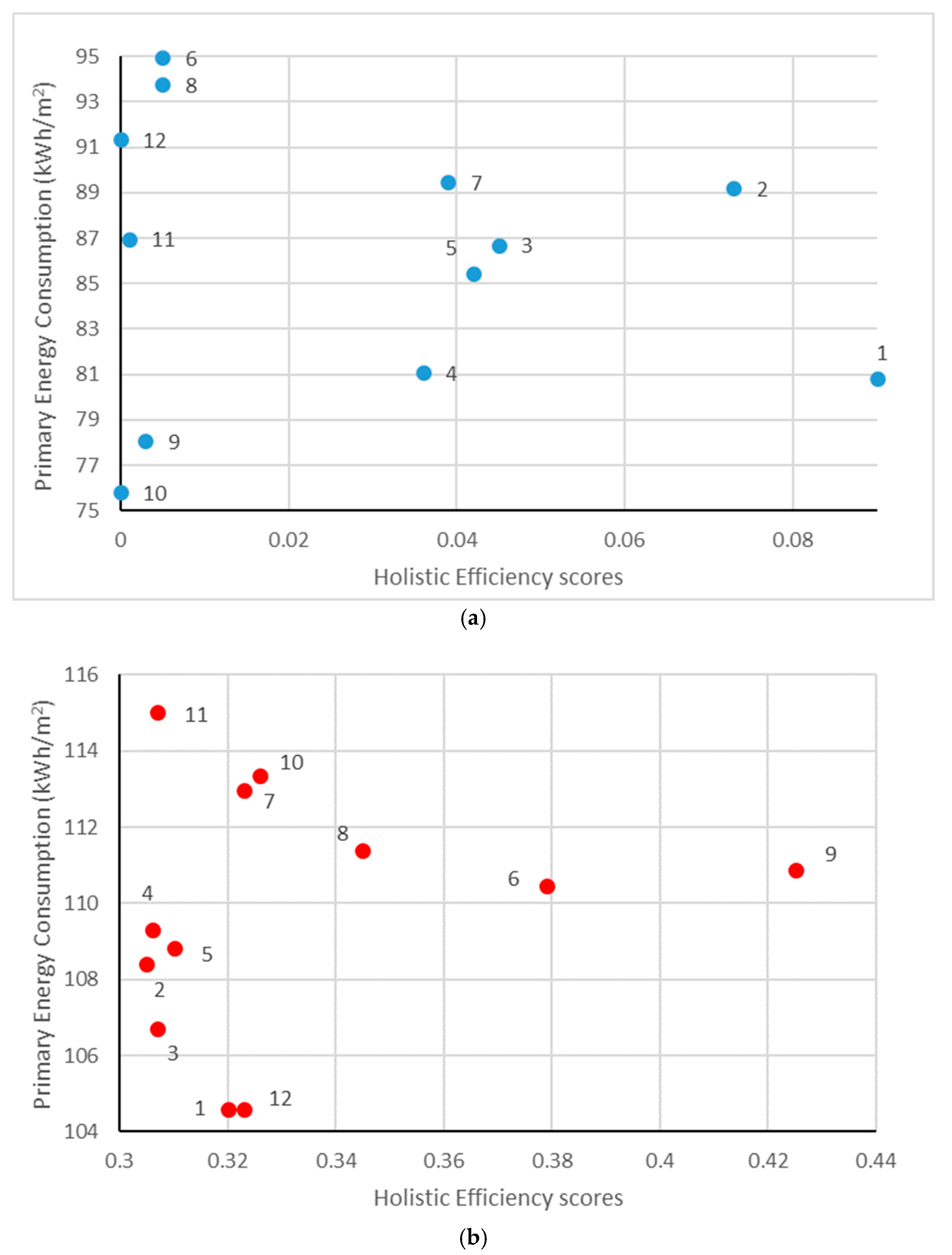
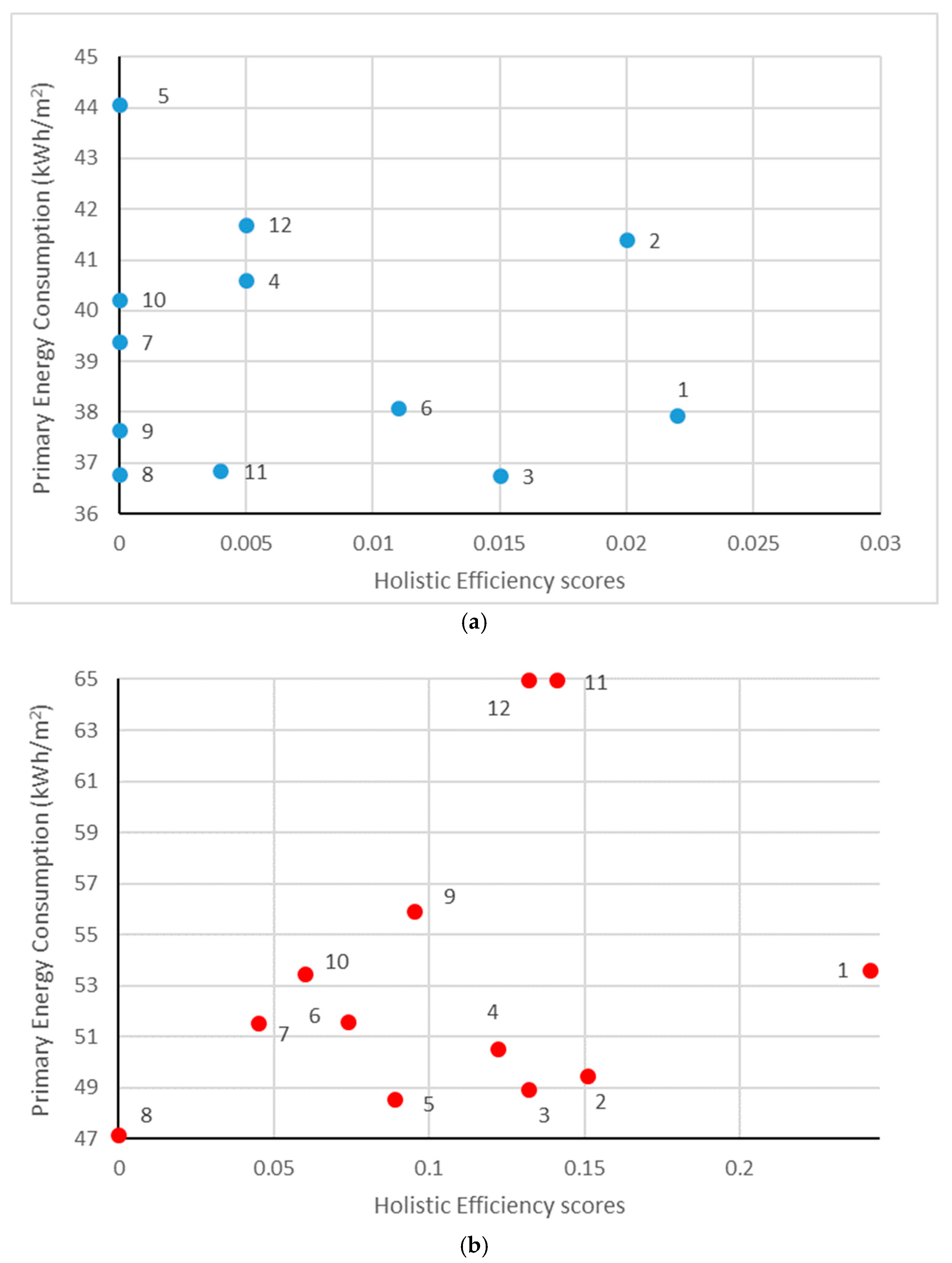
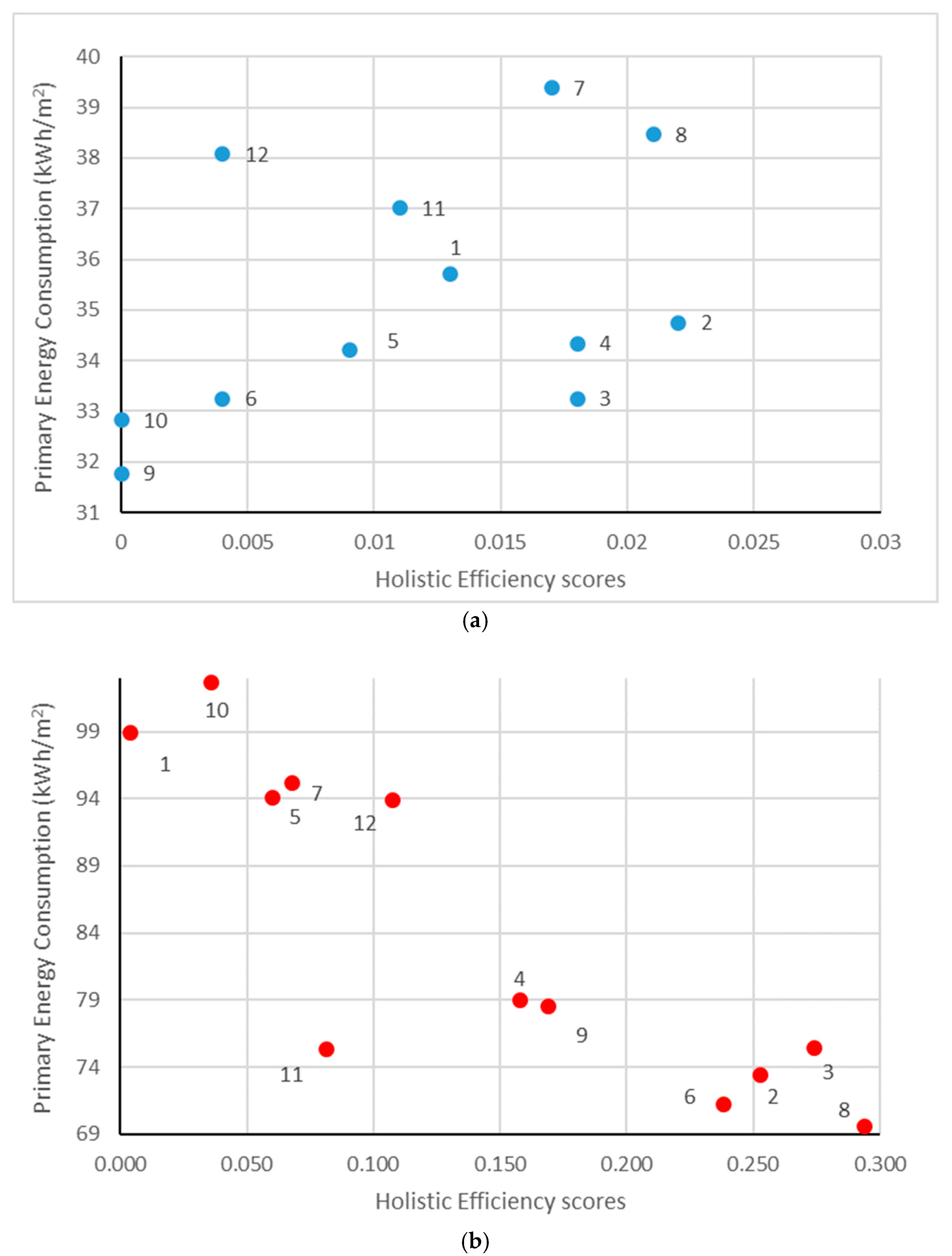
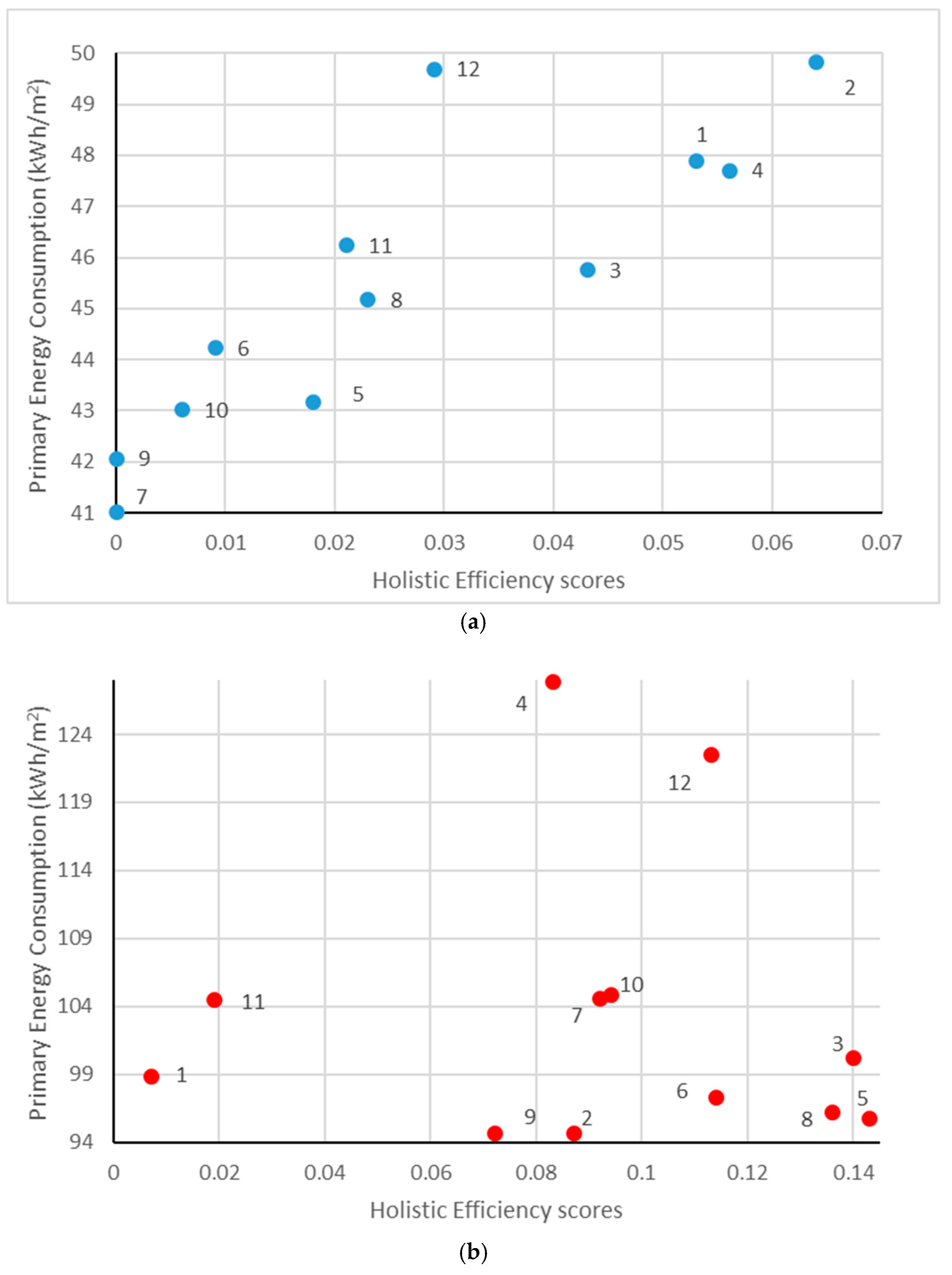
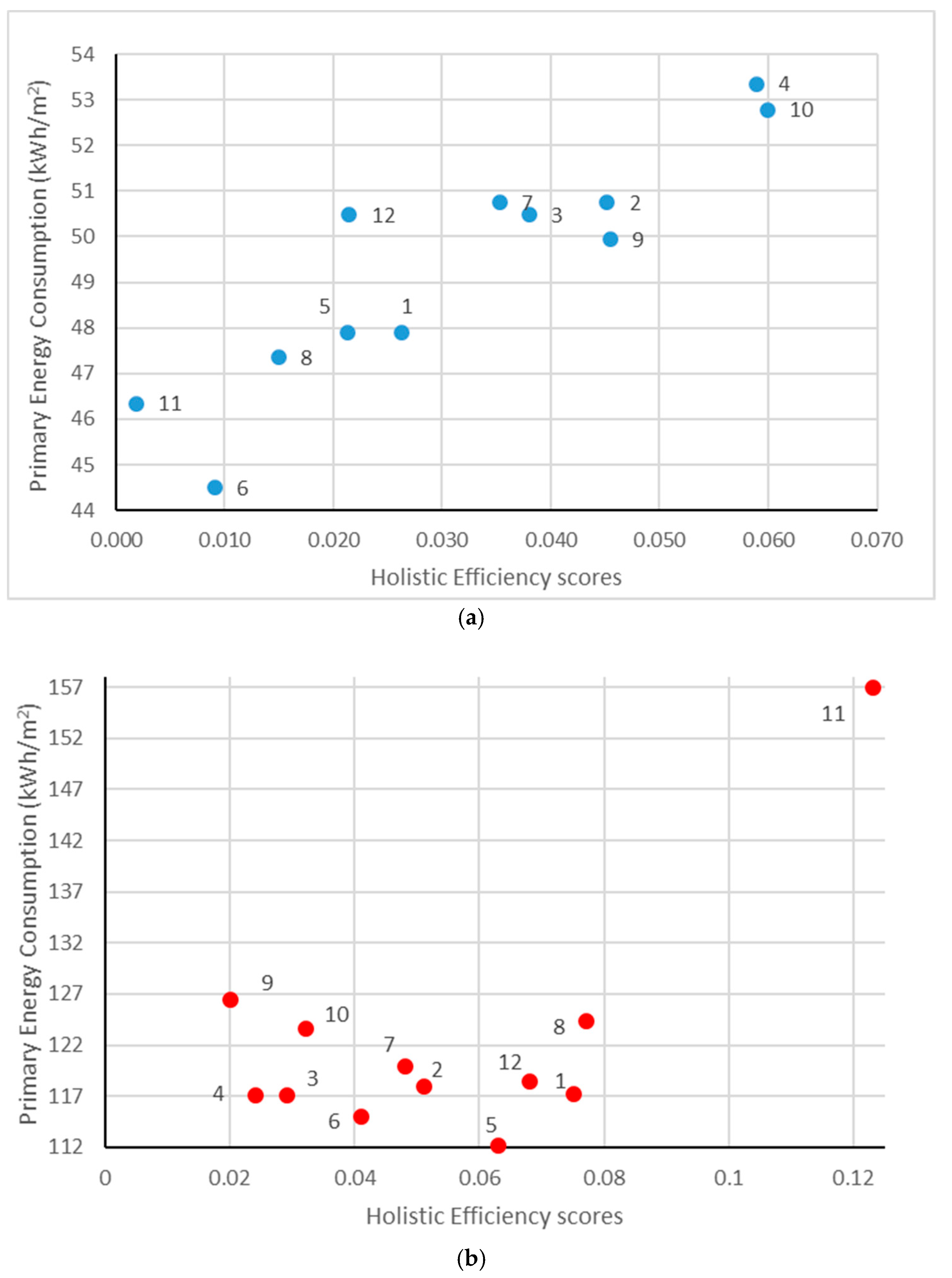
| Building Typology | Climate Zone | Pilot Study (Country/POS n°) | Pilot Study (Country/POS n°) | Sample Size (Number of Solutions) | DDF Frontier |
|---|---|---|---|---|---|
| SFH | W1S2 | CY (POS1) | HR (POS5) | 24 | 1 |
| W2S2 | CY (POS2) | HR (POS6) | 24 | 2 | |
| W2S3 | CY (POS3) | HR (POS7) | 24 | 3 | |
| W3S2 | CY (POS4) | HR (POS8) | 24 | 4 | |
| MFH | W1S2 | SP (POS13) | FR (POS9) | 24 | 5 |
| W2S2 | SP (POS14) | FR (POS10) | 24 | 6 | |
| W2S3 | SP (POS15) | FR (POS11) | 24 | 7 | |
| W3S2 | SP (POS16) | FR (POS12) | 24 | 8 |
| Building Typology | Input/ Output Space | Variables | W1S2 | W2S2 | W2S3 | W3S2 |
|---|---|---|---|---|---|---|
| SFH | Input (Model#1) | LCC (mean value, €/m2) | 143.10 | 178.47 | 219.18 | 234.50 |
| Input (Model#2) | Total costs (€) | 18,158 | 20,006 | 21,457 | 22,336 | |
| Undesirable output | CO2 emissions (kg/m2) | 9.24 | 12.25 | 16.15 | 17.12 | |
| Good output | Final energy saving per year (Mwh) | 13.50 | 21.57 | 25.45 | 36.94 | |
| MFH | Input (Model#1) | LCC (mean value, €/m2) | 115.64 | 155.71 | 189.20 | 199.21 |
| Input (Model#2) | Total costs (€) | 32,258 | 46,631 | 49,920 | 51,519 | |
| Undesirable output | CO2 emissions (kg/m2) | 8.81 | 10.75 | 14.05 | 14.97 | |
| Good output | Final energy saving per year (Mwh) | 31.69 | 33.80 | 41.05 | 58.94 |
| SOLUTION | W1S2 | W2S2 | W2S3 | W3S2 | ||||||||||||
|---|---|---|---|---|---|---|---|---|---|---|---|---|---|---|---|---|
| MODEL#1 | MODEL#2 | MODEL#1 | MODEL#2 | MODEL#1 | MODEL#2 | MODEL#1 | MODEL#2 | |||||||||
| CY POS1 | HR POS5 | CY POS1 | HR POS5 | CY POS2 | HR POS6 | CY POS2 | HR POS6 | CY POS3 | HR POS7 | CY POS3 | HR POS7 | CY POS4 | HR POS8 | CY POS4 | HR POS8 | |
| 1 | 0.032 | 0.160 | 0.198 | 0.140 | 0.023 | 0.121 | 0.031 | 0.014 | 0.017 | 0.032 | 0.045 | 0.040 | 0.090 | 0.320 | 0.076 | 0.285 |
| 2 | 0.022 | 0.159 | 0.160 | 0.102 | 0.036 | 0.149 | 0.121 | 0.095 | 0.018 | 0.119 | 0.024 | 0.022 | 0.073 | 0.305 | 0.257 | 0.330 |
| 3 | 0.021 | 0.155 | 0.143 | 0.120 | 0.024 | 0.144 | 0.113 | 0.081 | 0.003 | 0.118 | 0.134 | 0.024 | 0.045 | 0.307 | 0.093 | 0.290 |
| 4 | 0.019 | 0.155 | 0.148 | 0.100 | 0.033 | 0.116 | 0.165 | 0.083 | 0.005 | 0.084 | 0.153 | 0.017 | 0.036 | 0.306 | 0.000 | 0.353 |
| 5 | 0.014 | 0.157 | 0.128 | 0.086 | 0.001 | 0.102 | 0.014 | 0.192 | 0.005 | 0.118 | 0.061 | 0.085 | 0.042 | 0.310 | 0.069 | 0.334 |
| 6 | 0.010 | 0.155 | 0.113 | 0.085 | 0.005 | 0.191 | 0.037 | 0.135 | 0.006 | 0.184 | 0.058 | 0.067 | 0.005 | 0.379 | 0.263 | 0.368 |
| 7 | 0.000 | 0.114 | 0.177 | 0.037 | 0.009 | 0.174 | 0.040 | 0.056 | 0.016 | 0.138 | 0.149 | 0.081 | 0.039 | 0.323 | 0.093 | 0.422 |
| 8 | 0.007 | 0.121 | 0.117 | 0.009 | 0.003 | 0.194 | 0.021 | 0.027 | 0.014 | 0.162 | 0.235 | 0.117 | 0.005 | 0.345 | 0.215 | 0.428 |
| 9 | 0.000 | 0.000 | 0.101 | 0.000 | 0.006 | 0.261 | 0.087 | 0.130 | 0.000 | 0.000 | 0.050 | 0.000 | 0.003 | 0.425 | 0.070 | 0.396 |
| 10 | 0.000 | 0.101 | 0.140 | 0.039 | 0.013 | 0.190 | 0.097 | 0.032 | 0.003 | 0.133 | 0.160 | 0.136 | 0.000 | 0.326 | 0.131 | 0.409 |
| 11 | 0.003 | 0.110 | 0.124 | 0.024 | 0.001 | 0.171 | 0.089 | 0.098 | 0.001 | 0.140 | 0.064 | 0.129 | 0.001 | 0.307 | 0.015 | 0.422 |
| 12 | 0.000 | 0.117 | 0.128 | 0.010 | 0.000 | 0.104 | 0.140 | 0.310 | 0.000 | 0.136 | 0.227 | 0.092 | 0.000 | 0.323 | 0.029 | 0.261 |
| SOLUTION | W1S2 | W2S2 | W2S3 | W3S2 | ||||||||||||
|---|---|---|---|---|---|---|---|---|---|---|---|---|---|---|---|---|
| MODEL#1 | MODEL#2 | MODEL#1 | MODEL#2 | MODEL#1 | MODEL#2 | MODEL#1 | MODEL#2 | |||||||||
| FR POS9 | SP POS13 | FR POS9 | SP POS13 | FR POS10 | SP POS14 | FR POS10 | SP POS14 | FR POS11 | SP POS15 | FR POS11 | SP POS15 | FR POS12 | SP POS16 | FR POS12 | SP POS16 | |
| 1 | 0.022 | 0.242 | 0.069 | 0.376 | 0.013 | 0.004 | 0.413 | 0.776 | 0.053 | 0.007 | 0.552 | 0.132 | 0.026 | 0.068 | 0.582 | 0.048 |
| 2 | 0.020 | 0.151 | 0.151 | 0.211 | 0.022 | 0.253 | 0.322 | 0.143 | 0.064 | 0.087 | 0.498 | 0.056 | 0.045 | 0.051 | 0.549 | 0.160 |
| 3 | 0.015 | 0.132 | 0.032 | 0.174 | 0.018 | 0.274 | 0.403 | 0.197 | 0.043 | 0.140 | 0.535 | 0.097 | 0.038 | 0.029 | 0.645 | 0.022 |
| 4 | 0.005 | 0.122 | 0.087 | 0.150 | 0.018 | 0.169 | 0.357 | 0.062 | 0.056 | 0.083 | 0.511 | 0.818 | 0.059 | 0.024 | 0.643 | 0.040 |
| 5 | 0.000 | 0.089 | 0.187 | 0.125 | 0.009 | 0.060 | 0.232 | 0.243 | 0.018 | 0.143 | 0.305 | 0.058 | 0.021 | 0.063 | 0.369 | 0.064 |
| 6 | 0.011 | 0.074 | 0.046 | 0.064 | 0.004 | 0.238 | 0.370 | 0.012 | 0.009 | 0.114 | 0.455 | 0.023 | 0.009 | 0.041 | 0.038 | 0.038 |
| 7 | 0.000 | 0.045 | 0.043 | 0.029 | 0.017 | 0.068 | 0.483 | 0.277 | 0.000 | 0.094 | 0.033 | 0.047 | 0.035 | 0.048 | 0.615 | 0.092 |
| 8 | 0.000 | 0.000 | 0.000 | 0.000 | 0.021 | 0.294 | 0.509 | 0.000 | 0.023 | 0.136 | 0.505 | 0.000 | 0.015 | 0.077 | 0.467 | 0.195 |
| 9 | 0.000 | 0.095 | 0.008 | 0.074 | 0.000 | 0.158 | 0.351 | 0.086 | 0.000 | 0.072 | 0.445 | 0.055 | 0.045 | 0.020 | 0.662 | 0.089 |
| 10 | 0.000 | 0.060 | 0.062 | 0.028 | 0.000 | 0.036 | 0.322 | 0.301 | 0.006 | 0.092 | 0.410 | 0.074 | 0.060 | 0.032 | 0.660 | 0.132 |
| 11 | 0.004 | 0.141 | 0.009 | 0.095 | 0.011 | 0.081 | 0.461 | 0.078 | 0.021 | 0.019 | 0.507 | 0.049 | 0.002 | 0.123 | 0.236 | 0.938 |
| 12 | 0.005 | 0.132 | 0.115 | 0.076 | 0.004 | 0.107 | 0.367 | 0.059 | 0.029 | 0.113 | 0.445 | 0.001 | 0.021 | 0.075 | 0.522 | 0.059 |
| Solutions | W1S2 | W2S2 | W2S3 | W3S2 | ||||||||||||
|---|---|---|---|---|---|---|---|---|---|---|---|---|---|---|---|---|
| Primary Energy Consumption (kWh/m2) | LCC (€/m2) | Primary Energy Consumption (kWh/m2) | LCC (€/m2) | Primary Energy Consumption (kWh/m2) | LCC (€/m2) | Primary Energy Consumption (kWh/m2) | LCC (€/m2) | |||||||||
| CY POS1 | HR POS5 | CY POS1 | HR POS5 | CY POS2 | HR POS6 | CY POS2 | HR POS6 | CY POS3 | HR POS7 | CY POS3 | HR POS7 | CY POS4 | HR POS8 | CY POS4 | HR POS8 | |
| 1 | 44.95 | 57.05 | 123.31 | 150.60 | 56.64 | 88.89 | 156.18 | 194.44 | 69.75 | 80.06 | 200.82 | 231.29 | 80.80 | 104.60 | 211.03 | 237.47 |
| 2 | 43.00 | 54.22 | 125.07 | 152.50 | 59.89 | 92.34 | 156.45 | 194.70 | 68.45 | 66.12 | 200.85 | 233.13 | 89.20 | 108.41 | 218.30 | 240.79 |
| 3 | 40.04 | 56.13 | 125.49 | 153.92 | 60.23 | 94.30 | 158.02 | 195.69 | 80.26 | 69.15 | 201.00 | 233.62 | 86.69 | 106.72 | 220.60 | 240.94 |
| 4 | 41.47 | 54.26 | 126.11 | 154.74 | 63.43 | 90.46 | 158.22 | 195.78 | 81.63 | 83.26 | 201.11 | 233.97 | 81.07 | 109.30 | 222.06 | 241.11 |
| 5 | 39.41 | 53.18 | 126.63 | 155.61 | 50.58 | 97.68 | 160.87 | 196.39 | 73.58 | 89.54 | 202.16 | 235.34 | 85.44 | 108.81 | 222.33 | 242.14 |
| 6 | 38.09 | 51.27 | 127.20 | 156.37 | 47.51 | 93.90 | 160.89 | 196.46 | 72.29 | 85.09 | 202.21 | 235.80 | 94.95 | 110.47 | 227.49 | 244.16 |
| 7 | 47.18 | 57.05 | 127.26 | 161.75 | 53.83 | 97.00 | 162.08 | 196.46 | 84.21 | 75.49 | 202.56 | 236.26 | 89.47 | 112.96 | 229.32 | 244.19 |
| 8 | 39.53 | 54.22 | 127.84 | 163.65 | 50.75 | 95.86 | 162.11 | 196.72 | 85.56 | 71.14 | 202.63 | 236.27 | 93.76 | 111.40 | 229.39 | 244.56 |
| 9 | 37.47 | 51.92 | 128.34 | 164.04 | 60.30 | 86.22 | 162.31 | 196.81 | 72.72 | 81.46 | 203.97 | 236.92 | 78.05 | 110.88 | 230.46 | 245.51 |
| 10 | 45.22 | 59.79 | 128.98 | 164.70 | 63.56 | 102.04 | 162.60 | 196.94 | 84.74 | 67.46 | 204.54 | 237.97 | 75.79 | 113.36 | 230.87 | 245.53 |
| 11 | 42.21 | 56.13 | 129.36 | 165.07 | 63.89 | 99.23 | 164.18 | 197.13 | 76.50 | 78.32 | 205.23 | 237.98 | 86.97 | 115.01 | 231.64 | 247.53 |
| 12 | 43.67 | 54.26 | 130.03 | 165.89 | 67.11 | 98.45 | 164.39 | 197.35 | 88.62 | 92.52 | 205.97 | 238.74 | 91.34 | 104.60 | 231.91 | 248.62 |
| Solutions | W1S2 | W2S2 | W2S3 | W3S2 | ||||||||||||
|---|---|---|---|---|---|---|---|---|---|---|---|---|---|---|---|---|
| Primary Energy Consumption (kWh/m2) | LCC (€/m2) | Primary Energy Consumption (kWh/m2) | LCC (€/m2) | Primary Energy Consumption (kWh/m2) | LCC (€/m2) | Primary Energy Consumption (kWh/m2) | LCC (€/m2) | |||||||||
| FR POS9 | SP POS13 | FR POS9 | SP POS13 | FR POS10 | SP POS14 | FR POS10 | SP POS14 | FR POS11 | SP POS15 | FR POS11 | SP POS15 | FR POS12 | SP POS16 | FR POS12 | SP POS16 | |
| 1 | 37.94 | 53.59 | 88.24 | 126.69 | 35.72 | 98.97 | 115.21 | 179.60 | 47.89 | 98.92 | 134.84 | 230.05 | 47.90 | 118.51 | 133.17 | 250.20 |
| 2 | 41.40 | 49.47 | 88.55 | 128.30 | 34.76 | 73.47 | 115.30 | 180.76 | 49.84 | 94.67 | 135.40 | 233.93 | 50.77 | 118.01 | 133.51 | 250.72 |
| 3 | 36.75 | 48.95 | 88.90 | 129.78 | 33.26 | 75.50 | 115.82 | 186.37 | 45.76 | 100.29 | 135.52 | 234.32 | 50.49 | 117.20 | 134.61 | 260.84 |
| 4 | 40.59 | 50.52 | 89.81 | 133.05 | 34.35 | 78.60 | 115.93 | 192.47 | 47.71 | 127.89 | 136.08 | 235.62 | 53.36 | 117.16 | 134.98 | 261.04 |
| 5 | 44.06 | 48.57 | 90.15 | 136.38 | 34.22 | 94.14 | 117.03 | 194.81 | 43.17 | 95.80 | 138.16 | 236.52 | 47.90 | 112.24 | 135.62 | 261.71 |
| 6 | 38.09 | 51.59 | 90.25 | 143.27 | 33.26 | 71.29 | 117.12 | 195.15 | 44.24 | 97.33 | 138.79 | 239.44 | 44.52 | 115.12 | 135.66 | 262.66 |
| 7 | 39.39 | 51.52 | 90.45 | 145.19 | 39.40 | 95.20 | 117.30 | 195.91 | 41.03 | 104.86 | 138.80 | 243.34 | 50.77 | 120.00 | 135.97 | 264.77 |
| 8 | 36.78 | 47.16 | 90.49 | 145.40 | 38.47 | 69.59 | 117.48 | 195.93 | 45.18 | 96.23 | 138.84 | 243.47 | 47.36 | 124.40 | 135.98 | 265.16 |
| 9 | 37.64 | 55.90 | 90.56 | 148.95 | 31.78 | 79.04 | 117.66 | 200.07 | 42.08 | 94.68 | 139.40 | 244.54 | 49.96 | 126.56 | 136.32 | 266.57 |
| 10 | 40.22 | 53.45 | 90.78 | 151.27 | 32.84 | 102.70 | 117.74 | 201.91 | 43.03 | 104.67 | 139.46 | 245.77 | 52.80 | 123.67 | 136.61 | 267.87 |
| 11 | 36.84 | 64.95 | 90.81 | 152.93 | 37.02 | 75.37 | 118.07 | 202.68 | 46.25 | 104.50 | 139.46 | 249.33 | 46.35 | 157.03 | 136.96 | 269.14 |
| 12 | 41.70 | 64.95 | 90.88 | 154.34 | 38.09 | 93.92 | 118.13 | 208.58 | 49.70 | 122.54 | 140.02 | 249.70 | 50.49 | 117.22 | 137.06 | 273.84 |
Publisher’s Note: MDPI stays neutral with regard to jurisdictional claims in published maps and institutional affiliations. |
© 2021 by the authors. Licensee MDPI, Basel, Switzerland. This article is an open access article distributed under the terms and conditions of the Creative Commons Attribution (CC BY) license (https://creativecommons.org/licenses/by/4.0/).
Share and Cite
Cariola, M.; Falavigna, G.; Picenni, F. Holistic Impact and Environmental Efficiency of Retrofitting Interventions on Buildings in the Mediterranean Area: A Directional Distance Function Approach. Appl. Sci. 2021, 11, 10794. https://doi.org/10.3390/app112210794
Cariola M, Falavigna G, Picenni F. Holistic Impact and Environmental Efficiency of Retrofitting Interventions on Buildings in the Mediterranean Area: A Directional Distance Function Approach. Applied Sciences. 2021; 11(22):10794. https://doi.org/10.3390/app112210794
Chicago/Turabian StyleCariola, Monica, Greta Falavigna, and Francesca Picenni. 2021. "Holistic Impact and Environmental Efficiency of Retrofitting Interventions on Buildings in the Mediterranean Area: A Directional Distance Function Approach" Applied Sciences 11, no. 22: 10794. https://doi.org/10.3390/app112210794
APA StyleCariola, M., Falavigna, G., & Picenni, F. (2021). Holistic Impact and Environmental Efficiency of Retrofitting Interventions on Buildings in the Mediterranean Area: A Directional Distance Function Approach. Applied Sciences, 11(22), 10794. https://doi.org/10.3390/app112210794





